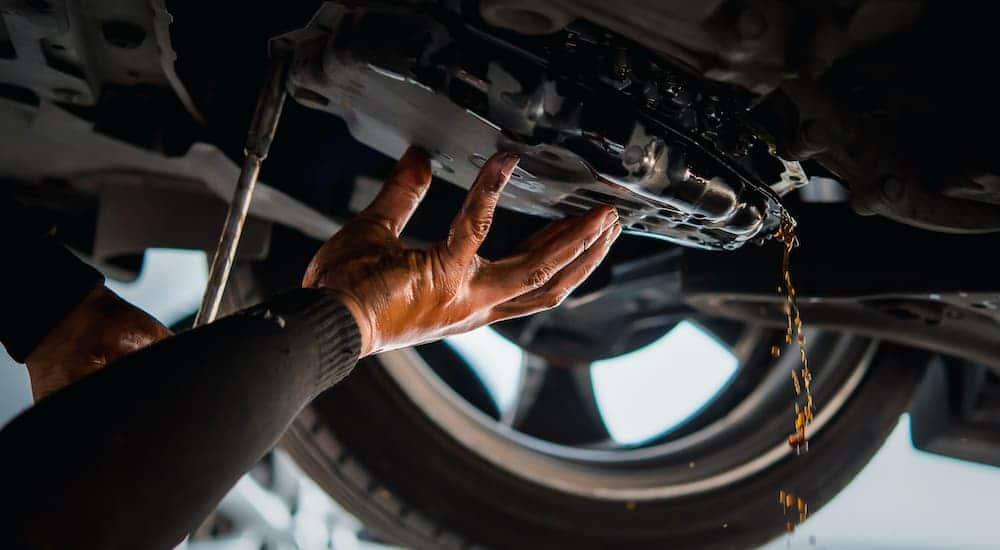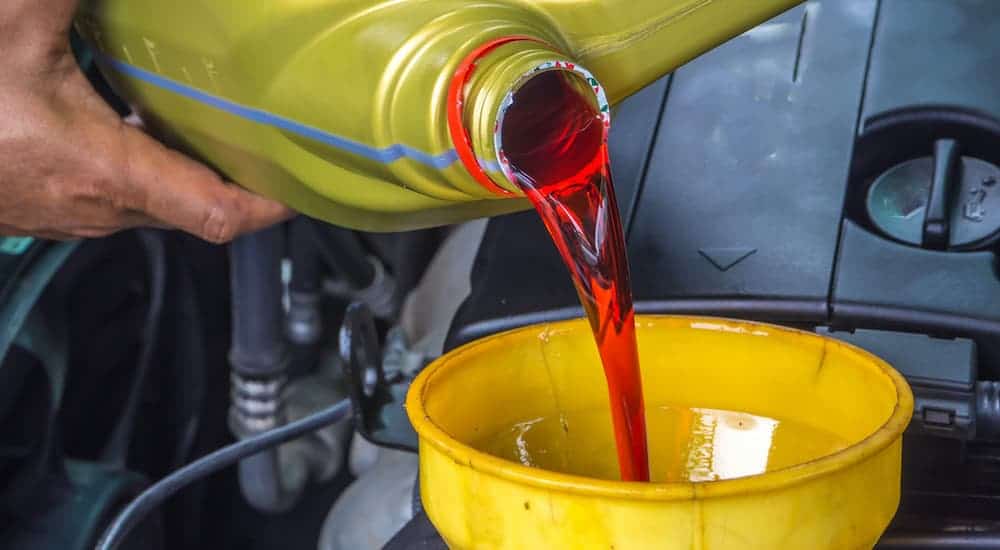I couldn’t believe it happened to me. I’d just pulled into a space next to the movie theater, all ready to see the latest superhero movie. Just as I stepped out of the car, I heard a dripping sound. Bending down, I could see liquid dripping from under my car’s engine. As I took a closer look, I noticed it was reddish in color: unmistakably transmission fluid. I called the service station and was lucky to find them open, and I just made it there with what was left of the transmission fluid in my car. This is what happens when you neglect transmission service.
How does transmission fluid work? Simply put, it provides lubrication and pressure necessary to operate an automatic transmission. Unlike a manual transmission, which operates with conventional gear oil lubricating the gears, levers, and linkages that you manually operate with your stick and clutch, an automatic transmission utilizes fluid to hydraulically change the gears when you drive. However, just like your engine oil, the transmission fluid will begin to breakdown over time and pick up minute bits of debris from the moving parts in the transmission that can also gum up the works.
This is why you need to stop by King Ford’s Quick Lane in Cincinnati for all your transmission needs before something goes wrong. Whether it is routine maintenance like changing your transmission fluid to diagnosing a more serious problem, our team of trained service technicians will use the newest tools to get your transmission back operating as good as new so you can get back on the road.
Transmission Fluid Is the Key to Making Your Engine Run Properly
Today, almost every vehicle uses an automatic transmission, whether it is a car, truck, van, or SUV. Not only are automatic transmissions convenient, but they are also more efficient than manual transmissions, providing generally better overall fuel economy. However, unlike manual transmissions, an automatic transmission requires the use of a specialized fluid. The base is a specialized oil with proprietary chemicals added to it to optimize overall performance. The fluid is also colored either green or red to distinguish it from engine oil, which is typically black, and other car fluids. The type, grade, and quality will often depend on the automaker, engine type, and transmission.
As a simple rule of thumb, there are basically three types of automatic transmissions. The conventional automatic is on most cars, trucks, and SUVs and features different speed settings, such as four, six, eight, nine, and ten, with the more settings providing you with greater control. Thus, a ten-speed automatic transmission will offer greater efficiency and performance than a four-speed, as you will have more gear settings.
A second type is the dual-clutch automatic transmission. This is similar to a conventional automatic transmission, but with one key difference: it will have different settings for odd and even gear sets. The dual-clutch transmission is most prevalent in sports cars. The third type is relatively recent but has become increasingly popular; the continuous variable transmission (CVT). A CVT replaces standard gear settings with a transmission that automatically and constantly adjusts the gear speed to the driving conditions. This will provide improved engine performance and greater fuel efficiency.
Your transmission fluid works by providing the hydraulic pressure for the automatic transmission system. Your engine has a part called a torque converter that uses its various components to propel the vital fluid through the transmission. As the fluid flows through the torque converter, it gains speed and increases pressure as it enters the transmission. While it lubricates the various parts of the transmission so it can operate properly, it also provides the hydraulic pressure needed for the transmission to shift gears, so your engine can go from a dead stop to overdrive in no time.
Routinely Checking the Transmission Fluid Is a Necessity
Now, let’s imagine we take that fluid out of your transmission. First, you will find that your engine can no longer shift gears. Without that vital transmission fluid, it no longer has the sufficient hydraulic pressure to go from neutral to drive and beyond. You will literally be stuck in first gear.
Second, the lack of transmission fluid will cause the heat to build up in the inner parts of your automatic transmission. This is because all of those moving parts create friction when they are working together. Friction causes heat, and heat causes wear and tear with eventual breakdown. The other purpose of the transmission fluid is to lubricate and cool all those parts, just like what oil does for your engine. If you take the transmission fluid out, you will get a very hot automatic transmission that will eventually grind to a halt.
You can take a number of routine steps to protect your transmission from getting damaged. First, you should check the level of transmission fluid on a regular basis. Most cars, trucks, and SUVs have a dipstick for the transmission fluid located in the rear of the engine compartment. However, you should check your car’s owner’s manual just to make sure.
Start your car and park it on a level surface. Keep your engine idling with the transmission shifted to park. Then open the hood, take a rag, and gently remove the dipstick. Wipe it down, replace it, and then pull it out again. There will be a level on it. If the fluid is not up to the full symbol, you will probably need to add more transmission fluid. You can either do this yourself or have a professional do it for you. Just remember to wipe the dipstick before putting it back in its place.
A second way to protect yourself is to get the transmission fluid routinely changed. Over time, the transmission fluid will lose its proper viscosity and also pick up minute bits of metal from the workings of your car’s automatic transmission. As a result, it will begin to change color. Transmission fluid should have a red or green color. If the color is getting darker, turning almost brown, it is time to have your transmission fluid changed.
Again, if you feel handy, this is something you can do yourself. However, you may want to have this done by a professional since you want to make sure you are putting in the proper brand and grade of transmission fluid. In addition, unless you have the proper tools, there is always the risk that you may not sufficiently tighten a bolt or, worse, you may even strip it if you tighten it too much.
Most service centers check the transmission fluid as part of the routine maintenance for your car, truck, or SUV. This entails making sure the level is right, checking the quality of the fluid, and replacing any that either leaked out or is no longer of the proper consistency. Some vehicle manufacturers even recommend replacing the transmission filter.
A low level of transmission fluid can also be an indicator of a bigger problem, like a leak or a problem with one of the parts of the transmission. Just like with anything else, you need to pay attention to your car. The worst thing to do is ignore a potential problem with your automatic transmission, as this can be one of the most expensive parts to repair or replace. In comparison, the cost of routine maintenance on your transmission fluid is relatively inexpensive and should be part of your regular maintenance.
I got lucky with my automatic transmission problem. It turned out that the leak was minor, and my service center’s professional staff was able to replace the transmission fluid I lost and repair the leak as well. However, had I ignored the problem, I could have done real harm to my vehicle. Riding on an engine with insufficient automatic transmission fluid can cause damage or even destroy the transmission. Instead, if you see a problem, take immediate action, and you’ll be back on the road in no time.



